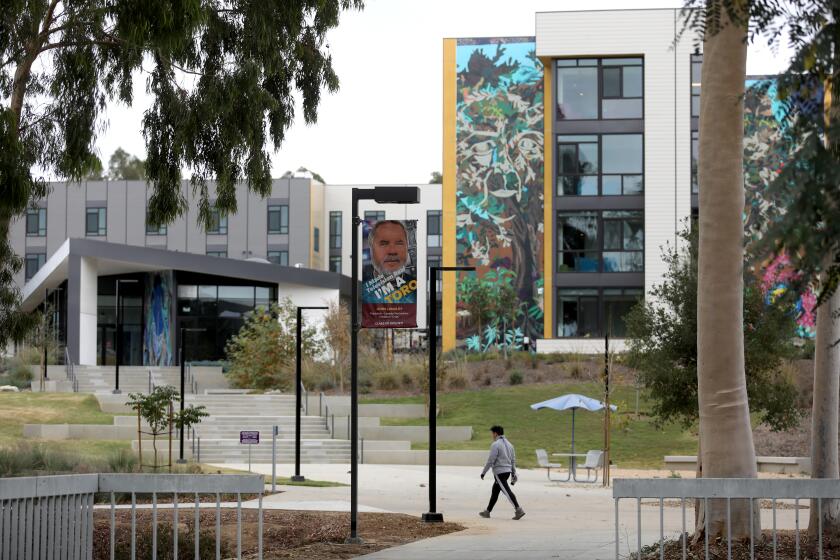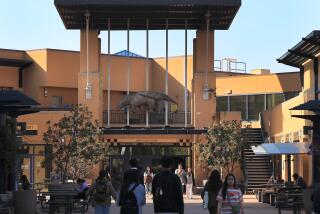California has the largest drop in spring college enrollment numbers in the nation

California leads the nation with the largest drop in spring 2021 college enrollment numbers largely due to a steep decline in community college students, who have particularly struggled with pandemic hardships, according to a report released Thursday.
The state’s overall community college and university headcount dropped by about 123,000 students — the largest numeric decrease of any state. The percentage decline was 5.3% .The numeric downturn reflects California’s stature as the most populous state, but does not account for the entirety of the loss, researchers said.
College enrollment across the nation dropped by 3.5% — or about 603,000 students — from spring 2020 to spring 2021, marking the biggest decline on record with the National Student Clearinghouse Research Center, which has tracked higher education enrollment and degree data since 2011. The calculation takes into account a decline of undergraduates and an increase in graduate students, the report by the organization says.
“California is doing worse than the national averages by 1 or 2 percentage points in terms of the declines this spring compared with last,” said Doug Shapiro, executive director of the organization.
The decline in community college students accounts for a large majority of California’s loss, which is in keeping with a national trend as community college enrollment was hardest hit by the pandemic. About 476,000 students, or 65% of the spring’s total national undergraduate enrollment losses, occurred in the community college sector, the report said.
The spring losses at California’s community colleges follow a similar trend in fall 2020, when enrollments dropped 12% compared to fall 2019. Additionally, students had to make spring semester registrations as the state experienced its largest and most devastating surge in COVID-19 cases and hospitalizations.
“The pandemic disrupted students’ lives in a myriad of ways that made it difficult or impossible for many of them to continue with their college educations,” said Paul Feist, spokesperson for the California Community College Chancellor Eloy Ortiz Oakley. Feist described the host of hardships that confronted students.
COVID-19 forced schools to shift to online learning. At CSU, it’s sticking around in what will be a new normal.
According to a state community college student survey, 41% faced a change in employment during the pandemic; about 19% had their work hours reduced and 22% were laid off or furloughed, Feist said. More than half of students reported their income decreased. About 57% faced basic needs insecurity — a group that was disproportionately made up of students of color.
New Mexico saw the biggest percentage decline in college and university enrollment, at 11.4%; Michigan was among the top five states with a 6.4% drop. When assessing the country by region, the South saw the smallest decline in enrollment at 1.9%. The West was next with a 3.7% decrease, followed by the Northeast with a 4% drop and the Midwest with a 4.1% decline.
Seven states — New Hampshire, Utah, West Virginia, Nebraska, Virginia, Idaho and Maryland — saw increased enrollment.
The drop in numbers at the community college level is due to a variety of factors, Shapiro said. Transfers from community colleges to four-year institutions account for a portion of the decline. But the most significant factor was a drop in fall and spring enrollment among high school students from the class of 2020. In addition, while a recession typically draws older students back to community colleges, that wasn’t the case this time.
“Literally every previous recession meant large increases in the number of older students enrolling in community colleges. This recession has completely broken that mold,” Shapiro said. “There’s no evidence of those millions of unemployed — they’re not going to college.”
A continued drop in enrollment could lead to decreased community college funding nationally, resulting in fewer classes, support services and further reductions over time, said Thomas Brock, director of the Community College Research Center.
“I think one of the greatest fears I have, and other leaders have, is that it could quickly become a downward spiral,” said Brock. “That would be the worst-case scenario.”
Many who work in essential industries, including construction, manufacturing and healthcare, have community college education, training and professional certifications.
“One of California’s prized possessions is our human capital in the state that drives the entertainment industry, that drives Silicon Valley and Silicon Beach,” Senior Vice President for the Campaign for College Opportunity Audrey Dow said. “If we don’t have a robust pipeline of individuals coming through our colleges and universities, all of that is threatened.”
It’s a mad commencement scramble to deliver some pomp to the Class of 2021. Universities are changing their plans the very week that wider reopenings are announced.
It’s too soon to say if the trend among community colleges will reverse in the fall, when campuses across the country reopen further for in-person learning.
The California State University, the largest four-year system in the nation, saw a record high overall enrollment in fall 2020, although the number of first-time freshmen dropped significantly, and enrollment fell at some Northern California campuses. UC enrollment in fall 2020 generally held steady for Californians but declined for nonresidents.
Brock is optimistic that the fall enrollment will improve nationwide, largely based on the waning pandemic and accessibility of vaccinations. But it will require work.
“The community colleges that I have spoken to are not approaching this passively,” he said. “They’re concerned about it and are trying to redouble their efforts to make clear they’re open and back in business.”
In California, recruiting efforts are underway to boost retention at community colleges for the upcoming semester.
“Retaining and attracting more students will be vital to California’s economic recovery and long-term well-being,” Feist said.
Are you a Southern California resident who recently left community college? Are you currently deciding whether to return, or to enroll for the first time? The Times would like to talk with you for an upcoming story. Please email reporter Colleen Shalby at colleen.shalby@latimes.com, or weigh in in the comments below.
More to Read
Start your day right
Sign up for Essential California for news, features and recommendations from the L.A. Times and beyond in your inbox six days a week.
You may occasionally receive promotional content from the Los Angeles Times.









